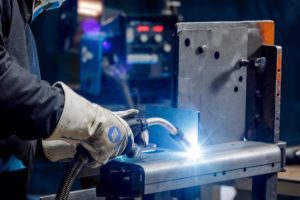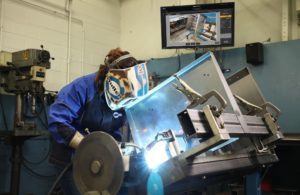How Much Time do You Spend Training New Welders?
Smarter machines and weld data monitoring offer more capabilities, which makes it easier to train welders and help them reduce mistakes.
Posted: January 28, 2022
WELDING TIPS
By Kodi Welch
For many operations, getting new welders up to speed faster is at the top of the priority list. Inexperienced or improperly trained welders can slow production and cause more rework and scrap, so proper training is a critical step. But there are ways that operations can save time in training new welders — and still produce the quality welds that are required.
Reduce welder training time in your operation with these four tips:
Rely on new technologies

Operators don’t want machines that are difficult to set up or adjust. In response, welding equipment manufacturers are removing complexity with simplified interfaces and push-button controls to reduce welder training time. Machines offering synergic control allow easy setup and simple parameter adjustment to help maintain a clean arc transfer and reduce defects that can occur from incorrect parameter settings. Additionally, some machines take synergic control a step further by matching parameter settings to material thickness. These technologies help less experienced operators maintain quality and productivity while reducing rework costs. Some systems can also limit weld parameter options to values chosen by the shop supervisor — helping keep operators welding with optimal parameters for producing quality welds.
Make a welding process change
Switching to a different welding process, like pulsed MIG, can reduce rework and welder training time. Today’s welding systems offer more pulsed capabilities. Pulsed welding is more forgiving to variations in operator technique, making it easier for welders of all skill levels to produce quality welds. There are different types of pulsed waveforms, from standard pulsed MIG to various advanced pulsed processes, and the technology continues to evolve. In general, advanced pulsed arcs help maintain a clean arc transfer through the wire-feed speed range of the filler wire, making it easier for welders to consistently produce a high-quality weld. The Accu-Pulse™ process from Miller provides a more forgiving arc and a 28 percent wider operating window compared to standard constant voltage (CV) MIG.

Use data to enhance training
If your operation struggles with rework or missed welds, weld data can provide insights to help you find solutions. Weld data monitoring systems can be tailored to monitor your key priorities, whether it’s welds that fall outside of specific parameters or missed welds in a sequence. You can pinpoint exactly where weld defects or missed welds are happening. Some solutions alert welders when a weld is missed or completed outside of acceptable parameters. These systems can also reduce training time by guiding welders through a weld sequence in real time using visualizations of the part. The operators can rely on clear and complete guidance during the fabrication or manufacturing process, using embedded videos, images, audio and other files.
Consider your filler metal
As welders develop their technique and build experience, they gain the ability to read puddle fluidity and bead size. This helps them know when the puddle is flowing and wetting into the base metal, providing the ability to place welds with smooth, uniform profiles and less spatter. While operator experience is key to this skill, the filler metal being used also plays a role in puddle fluidity, because some filler metals are more forgiving than others. Filler metals, like certain metal-cored wires, may provide a more fluid puddle resulting in a smoother bead profile with less spatter. Making a filler metal change in the welding operation can deliver benefits for ease of use, which is especially helpful when training new welders.
Shorten welder training time
Many companies face a demand to recruit and train more welders. Finding ways to train them more efficiently can deliver significant time and cost savings. Smarter machines and weld data monitoring offer more capabilities that make it easier to train welders, while also helping them reduce mistakes and learn proper techniques to produce high-quality welds. www.millerwelds.com






